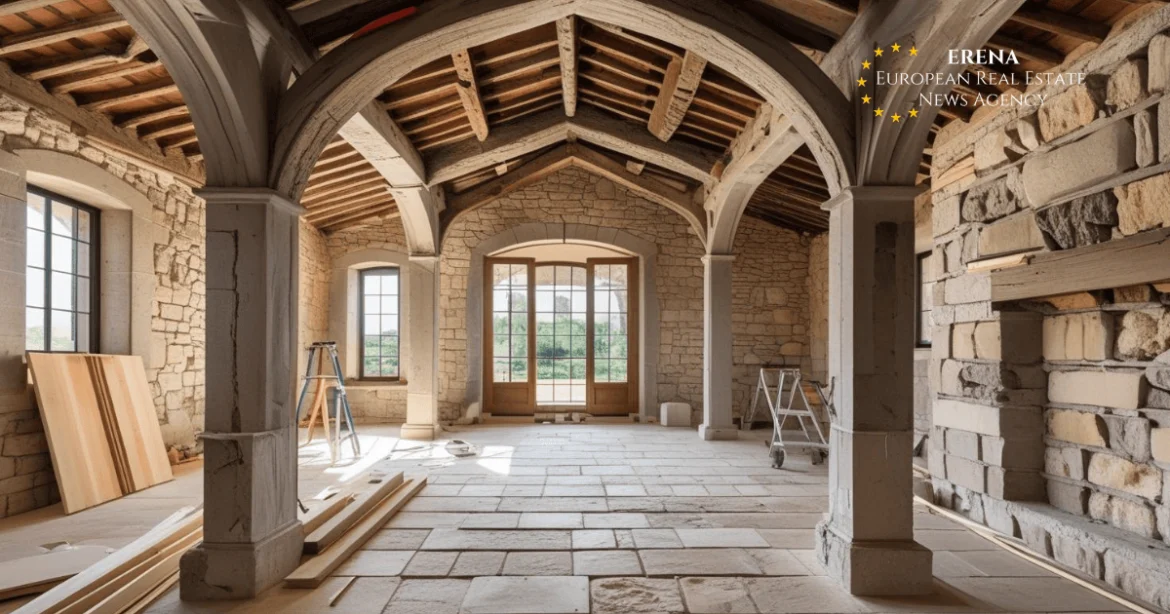Italy’s 16th-century farmhouses, or casali, are among the country’s most distinctive architectural treasures. Built from local stone, heavy wooden beams, and handmade terracotta, these rustic estates once formed the backbone of agricultural life across Tuscany, Umbria, Veneto, and beyond. Today, they are coveted by both Italians and international buyers who view them as cultural icons and long-term investments.
Many stand abandoned, weathered by centuries of neglect. Yet for buyers willing to take on the challenge, restoring a Renaissance-era farmhouse can deliver not just a dream home but also a valuable asset with potential rental income.
What the Restoration Really Costs
Experts estimate that reviving a farmhouse from the 1500s typically costs €1,000 to €3,000 per square meter, depending on the building’s condition, the type of materials used, and the complexity of required interventions.
At the lower end of the range are homes that are structurally sound but in need of modernization — electrical systems, plumbing, roof repair, and interior finishes. At the higher end are semi-ruins requiring seismic upgrades, full roof reconstruction, and extensive masonry consolidation.
Typical Cost Items
- Roof replacement: €130–300 per m²
- Stone masonry repairs: €300–850 per m³
- Electrical renewal: €3,500–10,000+ per project
- Windows: €400–800 each
- Seismic upgrades: €300–500 per m²
For a 200 m² farmhouse, this translates into €280,000–€600,000 in construction costs before fees and taxes. Larger projects, such as a 300 m² property in partial ruin, can easily surpass €700,000.
Real Buyer Stories
The dream of turning ruins into modern homes is not just theoretical. In Puglia, architect Nino Filotico reports being overwhelmed with renovation requests from both domestic and foreign clients.
One British buyer, Adam Chappell, acquired a 500-year-old farmhouse near Nardò for just €70,000. His restoration budget: around €200,000. Once complete, the project will deliver a comfortable three-bedroom residence with an attached rental unit. His case illustrates the viability of restoring such properties within the expected per-square-meter cost bands.
The Bureaucratic Hurdle
While the romance of a Renaissance home is powerful, the reality involves navigating Italy’s intricate building rules. If the farmhouse is protected as a cultural asset, works must be approved by the Soprintendenza, Italy’s heritage authority.
Under D.Lgs 42/2004, even maintenance on listed buildings requires authorization. Once full documentation is submitted, the Soprintendenza has 120 days to respond, often with specific prescriptions on materials and methods.
Professional design and supervision fees usually add 5–15% of the project cost. Municipal permit fees can range from €1,000 to €3,000, depending on the size of the project and whether the property falls under landscape or heritage restrictions.
Tax Breaks and Incentives in 2025
The Italian government continues to encourage renovations through a system of tax deductions.
- Renovation Bonus (Bonus Ristrutturazione): 50% deduction in 2025 for primary residences, capped at €96,000. For other properties, the rate is generally 36%.
- Sismabonus: 50% deduction for seismic works in 2025.
- Reduced VAT: Most renovation services qualify for a 10% VAT rate, although some “significant goods” like boilers or windows may still carry partial 22% VAT.
For many buyers, these deductions can substantially reduce the financial burden of restoring a farmhouse, especially when combined with long-term rental income potential.
Timeframes and Risks
A full restoration project usually unfolds over 12–24 months, split between design, permits, and construction. For listed farmhouses, add the 120-day Soprintendenza window plus time for surveys and possible resubmissions.
Buyers are advised to budget 10–15% contingency for hidden issues. Common cost drivers include rotted timber beams, seismic retrofits, poor drainage, and outdated service connections.
Why People Still Buy Them
Despite the costs and bureaucracy, demand remains strong. Rural Italy still offers unrenovated stock at relatively low purchase prices — sometimes under €1,000 per m² in southern regions, compared to €2,500 per m² in Tuscany’s Chianti. For some buyers, the initial low purchase price balances out the higher renovation budget.
For many, the decision is as emotional as it is financial. Restoring a centuries-old farmhouse represents a chance to own a piece of Italian history, enjoy a lifestyle surrounded by vineyards and olive groves, and potentially create a profitable rental business.
The Bottom Line
Restoring a 16th-century Italian farmhouse is a balancing act between romance and reality. The costs are significant — €1,000 to €3,000 per m² — but the rewards extend far beyond numbers. With careful planning, tax incentives, and professional guidance, buyers can transform abandoned ruins into timeless estates.
What remains constant is the allure: the opportunity to revive a fragment of Renaissance Italy and live within walls that have already stood for 500 years.

